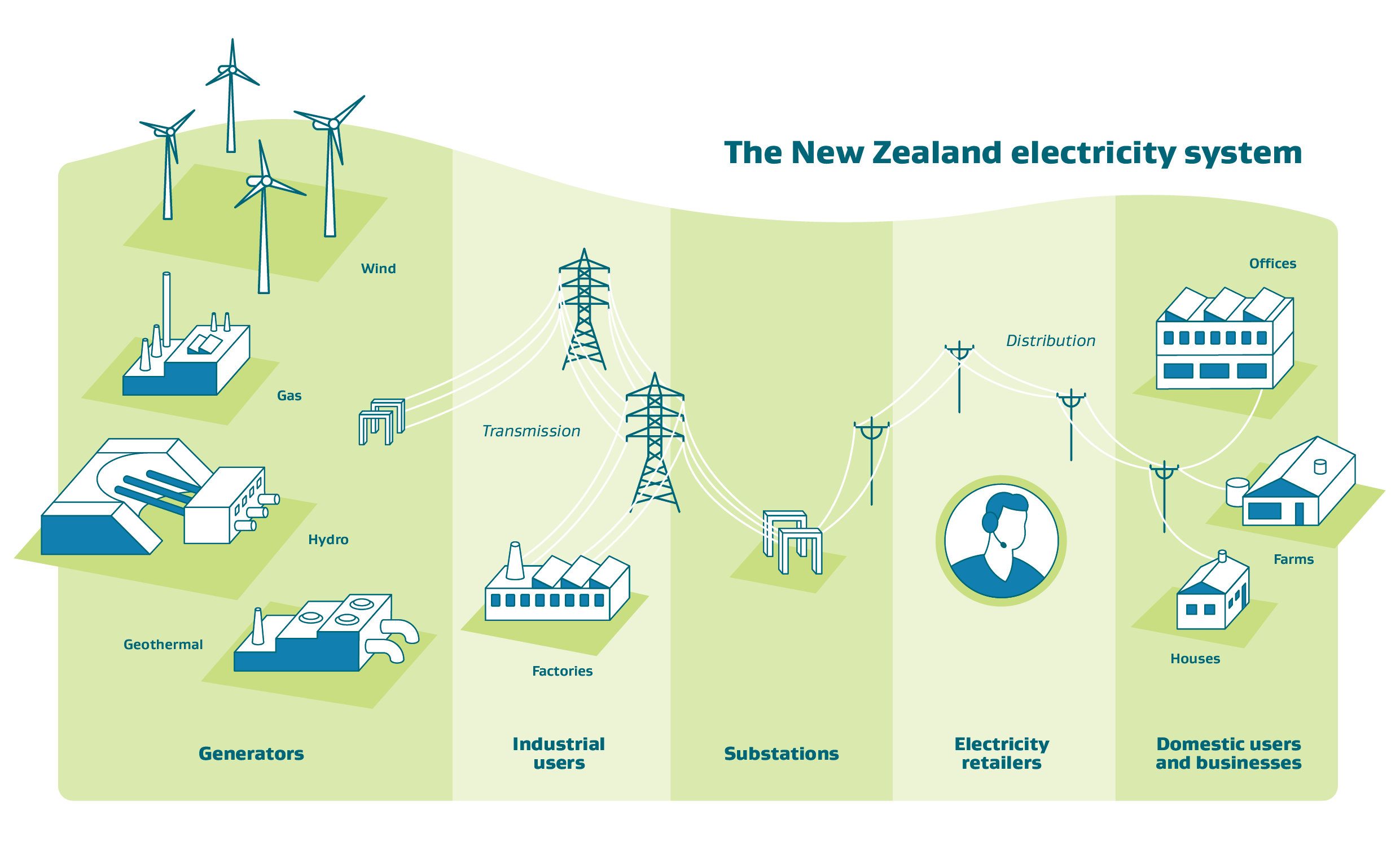Electricity industry
The electricity industry in New Zealand has 4 main components – generation, transmission, distribution and retail.
On this page

Text description
Electricity generation
In New Zealand electricity is generated by 4 major electricity generating companies. Genesis Energy, Mercury and Meridian Energy operate under a mixed ownership model in which the government holds a majority stake, while Contact is a private sector company.
Generation companies own and operate power stations across the country. Most of New Zealand’s electricity is generated at remote locations and requires an efficient transmission system to transport it to the main centres.
More than 200 generation plants are able to supply electricity to the national grid. Some of the smaller-scale generation is ‘embedded’ and feeds directly into local distribution networks.
For more information about New Zealand’s electricity sector, see Electricity statistics.
Electricity transmission
State-owned enterprise Transpower owns and operates New Zealand’s national electricity transmission system. The system includes substations, high voltage cables, transformers and overhead lines for transmitting high voltage electricity from power stations to distribution (lines) companies.
The electricity grid
New Zealand’s electricity grid is an AC transmission system, with a DC connection from the southern South Island at Benmore Station on the Waitaki River, across Cook Strait by undersea cable to the southern end of the North Island. This type of transmission is called a high voltage direct current (HVDC) system.
Transpower transmits most of New Zealand’s electrical energy using high capacity, high voltage transmission lines to regional distribution companies. It also supplies electricity directly to some large industrial companies.
Coordinating the grid
Transpower also provides a network coordination service. It:
- schedules the generation of all power stations
- monitors interconnected networks
- ensures that reliability, voltage and frequency targets are met
- manages grid emergencies.
The Electricity Authority manages a service provider contract with Transpower to ensure effective grid management. As system operator, Transpower is responsible for the real-time operation of the electricity system.
Under the Electricity Industry Act 2010, the system operator must also provide information and forecasts on the security of supply, and to manage supply emergencies.
Related links
Transpower website(external link)
Electricity Authority website(external link)
Electricity Industry Act 2010 on the New Zealand Legislation website(external link)
Electricity retail
In New Zealand there is a high degree of vertical integration between electricity generation and retail as the 4 main retail companies are also the main generating companies.
View the latest electricity retail market share trends(external link)
Bundled electricity services
Electricity retailers provide a ‘bundled’ service for most consumers by buying electricity at wholesale (spot and contract) prices from the generating companies, and transmission or distribution services from lines companies.
The retailers' charges to the end-users include the cost of the electricity supplied as well as charges for transmission and distribution. Some large consumers contract separately with retailers and lines companies for energy and network services.
Electricity billing
In some cases, retailers may provide a billing service for lines companies that contract separately with consumers, or lines companies may separately bill customers for their services.
To find out more about line and retail charges, see Electricity prices.
Chronology of New Zealand electricity reform
In the early 1980s, the Government launched a major inter-departmental review of the Crown's role in the electricity industry. The review aimed to separate operational functions from other functions. It also sought to improve commercial performance and introduce commercial disciplines for trading activities.
The chronology traces key events from the early days of the review to the present day.

